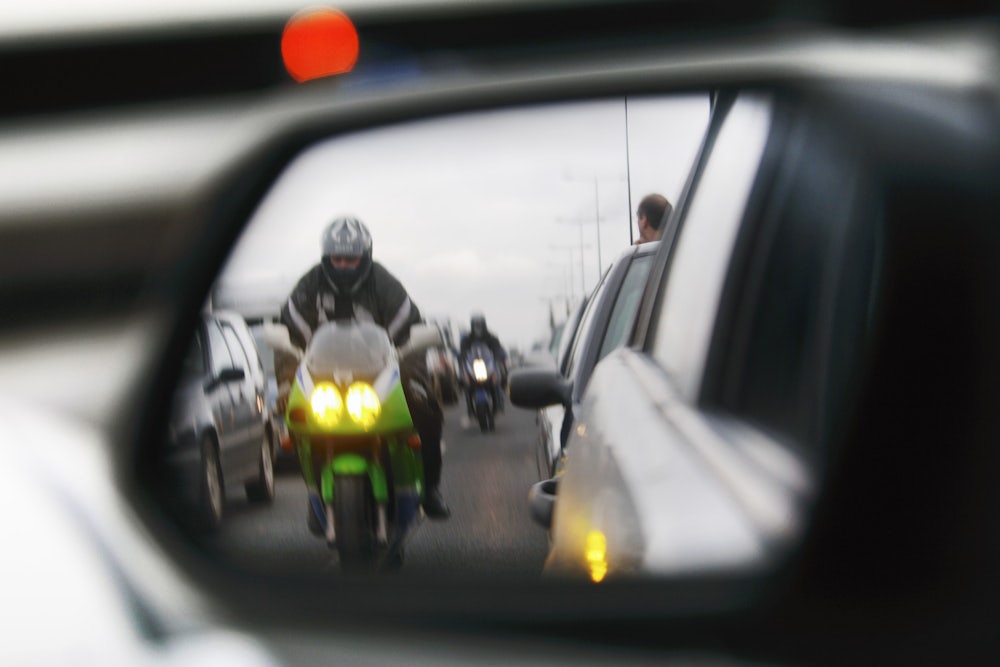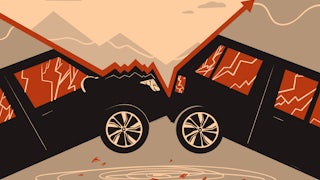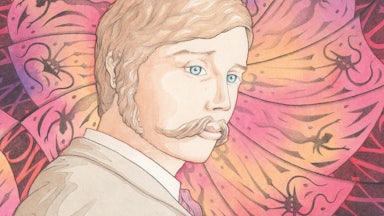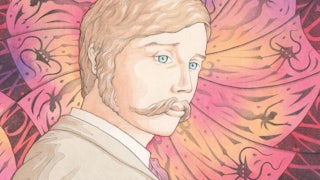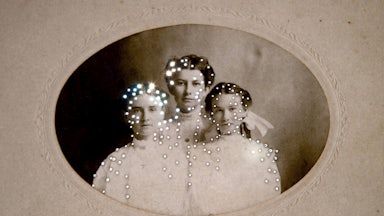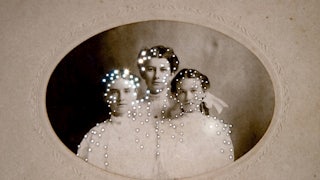On December 1, 2006, a man named Eric Ng was killed on his way home from work. He had been biking along the Hudson River, on what was then, and remains now, the most heavily used bike path in the United States. A car swerved onto the bike path, collided with Ng, and killed him. He was only 22 years old. It would later be revealed that the driver was drunk and had just left a holiday party. He had been speeding and left the road for the bike path to avoid a traffic jam. The man was given an “indeterminate” prison sentence of 3 1/2 to 10 1/2 years. At Clarkson Street, Ng’s friends installed a “ghost bike” to commemorate Ng’s life. Stripped down and spray-painted matte white, the bike gave the eerie impression of being a photonegative, a visible absence.
Jessie Singer attended the driver’s sentencing. Ng was her best friend, and she had painted New York City’s first ghost bike in 2005, not long before losing him. In her new book, There Are No Accidents: The Deadly Rise of Injury and Disaster―Who Profits and Who Pays the Price, Singer summons the feeling of nervous dread that enveloped her that day: “The wood-walled courtroom [was] divided into victim and perpetrator like a wedding no one wants to attend.” In expressing his contrition, the killer told the court how sorry he was “for this accident that happened.”

That day in court, Singer barely registered the word “accident” and “did not question it.” Yet she noticed how many people were dying preventable deaths, as her friend had, and how many of those deaths were written off as “accidents.” On the very same bike path where Ng died, Singer found, a doctor had been run over and killed by a police tow truck driver less than a year earlier. And in 2017, a terrorist plowed a truck full speed down the path, killing eight people and maiming many others. “The accident that killed Eric was a road map for a murderer,” Singer observes. For the past 15 years, she has continued to paint and install ghost bikes; to date, she has worked on more than 250 bikes in New York alone. And working with Transportation Alternatives, she helped launch a campaign called “Crash, Not Accident” to pressure the media and public officials to stop using the word “accident” when referring to vehicular crashes.
There Are No Accidents looks at a wider range of fatalities that have been chalked up, at various times in the past century, as accidents or mere flukes: not just car crashes but also toxic chemical spills, catastrophic mine explosions, collapsed bridges, the Boeing 737 Max plane crashes, opioid overdoses, and more. In chapter after chapter, Singer makes the case that we should think of accidents not as “chance mishaps but systemic inevitabilities.” The stories she tells share a theme: that in the U.S. whether a person’s death is deemed an accident or not is largely a measure of that person’s proximity to power. The “power to demand that your workplace is safe, the power to fireproof your home, the power to drive instead of walk” all lower the risk of so-called accidental death. Because accidents, she argues, often provide cover for flaws in infrastructure, systemic racism, ableism, and a host of other ills.
The vogue for declaring certain categories of death “accidents” is older than we may think. “From the Industrial Revolution onward, powerful corporate interests insisted that fallible people were the source of all accidents,” Singer writes. Railroads provided some of the earliest data for accidental worker deaths; almost half of those injured or killed on the job were workers who connected train cars. Many were dismissed as “careless, drunk, or dumb.” When newspapers began reporting on the death toll of railroad workers (recorded at 11,000 in 1892), Congress took note and passed the Safety Appliance Act. The act mandated automatic couplers, saving workers the trouble of standing between two railcars and jeopardizing their lives. The number of lives lost to coupling train cars dropped by thousands in subsequent years. The problem was not individual reckless workers but an unsafe system.
By the time something manifests as an accident, a row of dominoes has already been set in motion. Singer’s favored metaphor for the onset of accidents is a stack of Swiss cheese. Each layer of cheese is supposed to add a slice of safety; it is supposed to cover the holes in previous layers, even as it brings its own holes. In cars, airbags, seat belts, sun visors, padded dashboards, and recessed steering wheels (less likely to impale drivers in a collision) are each meant to add a layer of protection; similarly, fire sprinklers, fire extinguishers, and fire escapes in buildings all lower the chances of someone dying in a fire. An accident, in this schema, is what happens when the holes in several layers of cheese line up perfectly: an aperture of atrocity.
In the 1960s, Ralph Nader began to look at the set of conditions that made driving a car so dangerous. Before Nader came on the scene, car manufacturers liked to blame car crashes on “the nut behind the wheel.” In his 1965 book, Unsafe at Any Speed, Nader debunked this talking point, showing how the major danger on the roads lay in the design of cars, rather than in the faults of drivers. He exposed, for instance, how Ford had deliberately delayed installing seat belts in cars in order to cut down on production costs and how the company prioritized design over safety by keeping dangerous features like protruding instrument panels in its vehicles. Such features made collisions much deadlier than they had to be. There was no Swiss cheese to protect a driver who made a mistake on the road. Nader testified before Congress on the need to protect drivers “from paying the ultimate penalty for a moment’s carelessness,” advocating for the adoption of safety features in new cars. His efforts worked; they also led to the creation of several federal agencies, including the Occupational Safety and Health Administration, the Environmental Protection Agency, the Consumer Product Safety Commission, and the National Highway Traffic Safety Administration.
Yet in the years that followed Nader’s successes, progress on safety slowed, as industry interests gained control over large parts of the regulatory process. To take one example, the NHTSA—the agency empowered to assess the “crashworthiness” of cars—still uses dummies that are modeled on male bodies. “No crash test dummies account for the physiological differences between male and female bodies—in chest, shoulders, and hips—or the presence of breasts, or most females’ physical size,” Singer writes. Because of oversights like these, women are 73 percent more likely to be injured and 28 percent more likely to be killed in a car crash.
American safety standards lag behind those of many other countries. While cars in some European countries come with pedestrian bonnets, or exterior air bags that pop up if cars smash into pedestrians, cars made in the U.S. have no such feature. According to Joan Claybrook, former head of the NHTSA, the agency has all but abdicated its regulatory responsibility. Its investigations into vehicle defects dropped by more than 93 percent between 1989 and 2017.
The advent of driverless cars poses a further set of challenges. As Claybrook tells Singer, there is no analogous “vision test” that autonomous cars have to “pass”: “NHTSA has required no proof that the vehicles’ sensors can see in daylight or in darkness, or can identify small objects, children, animals, or markings on the highway.” In some states, automakers can even test self-driving cars on public roads. All this paints a grim scenario for the future. “We’ll soon see deaths born not of human mistakes but of the inhuman nature of machines programmed to ignore human life,” writes Singer.
The likelihood of dying by accident in the U.S. is nontrivial: One in 24 people die this way. The pattern of these deaths maps onto stark inequalities in society. Race is a major risk factor for accidental death: Not only are people of color more likely to live near high-risk chemical facilities than white people are, but “accidents” at those facilities happen twice as often in Black neighborhoods as in white ones. Black people are twice as likely to die in accidental fires as white people, and both Black and Indigenous people are more likely than white people to be fatally struck by a driver while crossing the street. The same holds for being shot by accident, freezing to death, and burning to death—race inflects almost every way to die by accident. Black people also are more likely to be accused of causing accidents—like driving a car that hits someone. In a society structured by racism, risks fall disproportionately on people of color, while racism also makes it easier to blame accidental deaths on the communities they affect most severely and forgo attempts to make them safer.
Do we need to cut the word “accidents” from our vocabulary? Singer writes that she does not use the term “accident” in daily life—though she does use it in the book, she says, so that readers can make up their own minds on how it should be used.
For this reader at least, it makes more sense to stop saying “accident” to describe broad categories of deaths, but it can make sense to describe an individual’s experience as an accident. In a well-known paper titled “Moral Luck,” the philosophers Bernard Williams and Thomas Nagel wrestle with the problem of assigning moral weight to accidents, or “contingent enemies of tranquility.” As the title of the paper indicates, they make no bones about calling things “accidents” or a matter of “luck.” They present a hypothetical case similar to one of many such cases cited by Singer: A driver runs over a child. “If the driver was guilty of even a minor degree of negligence,” they write, then “he will blame himself for its death.” For the philosophers, the scenario was an instance of “moral bad luck.” Singer might be inclined to disagree, but nothing should prevent us from holding the two ideas in mind at once: There’s nothing accidental about poorly designed cars and roads that make deaths statistically more likely, but being the driver who lapses in attention in those poor conditions can be seen as a matter of bad luck.
It’s when we look at lots of instances of “bad luck” in the aggregate that we need a better framework. We should also train ourselves to pay special attention to instances where discrete experiences line up; these should signal to us that something more is going on than meets the eye—that we may not be at the mercy of bad luck so much as of systemic failures to implement necessary layers of safeguards. For these phenomena, we need more accurate terminology. Instead of “car accidents,” we might say “unregulated automated deaths” or, to borrow a term from Ralph Nader, “corporate homicide.”
In a closing chapter, Singer offers more than a handful of useful suggestions for ways to curb the “accident epidemic.” We can start by renouncing our proclivity for punishment and stop “pretending that people are perfectible.” This can be difficult: Cognitively, we are predisposed to see our own accidents as a function of our environment but view other people’s accidents as a failure of personal responsibility. As a society, we should uphold restorative justice laws and build workplaces, roads, and homes using a harm reduction model. We can repeal tort reform laws that make it harder for injured individuals to sue companies. We can keep a vigilant eye on the capture of government agencies by industry and place more restrictions on lobbyists being able to take government jobs. It should be harder for companies simply to factor in accidents as a cost of doing business. All these measures can act like so many layers of Swiss cheese, reducing the likelihood that holes of oversight will line up and cause an accident.
At a more individual level, Singer proposes that we adopt the perspectives of the most vulnerable members of our society—the young and the old, the disabled and the poor. This means, for instance, making sure that our work environments are equipped with ramps and grab bars. We can also try to opt for more environmentally friendly and less risky modes of transportation, like walking, biking, and riding the bus. If we must buy a car, we can opt for a smaller model that poses less danger to pedestrians. We can also make sure that pills are out of the reach of children and guns are locked away.
Calling something an accident can be an effective release valve for our emotions. Singer doesn’t deny this; she even writes that she wants to honor the wishes of those who find some measure of peace by privately grieving painful accidents and wouldn’t presume to police what they can or cannot say. But Singer doesn’t want corporations and political leaders to be able to hide behind accidents. To label something an “accident” can often just be a convenient way of explaining away, or endlessly deferring, problems with laws, toothless regulations, and lack of oversight. “Accidents are a political and social problem,” Singer insists. If our leaders didn’t have such a convenient term to fall back on, they would have a lot more explaining to do.
